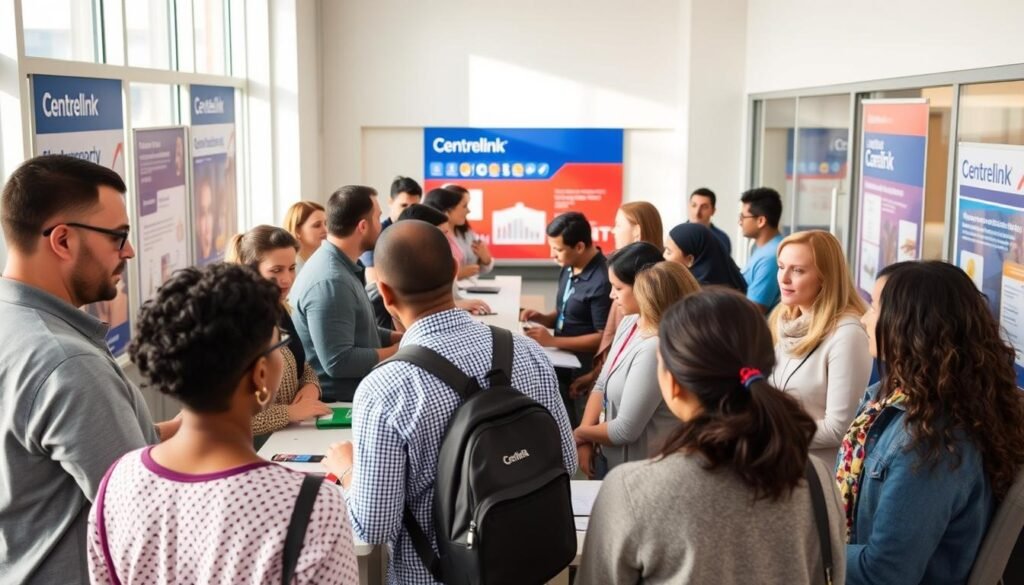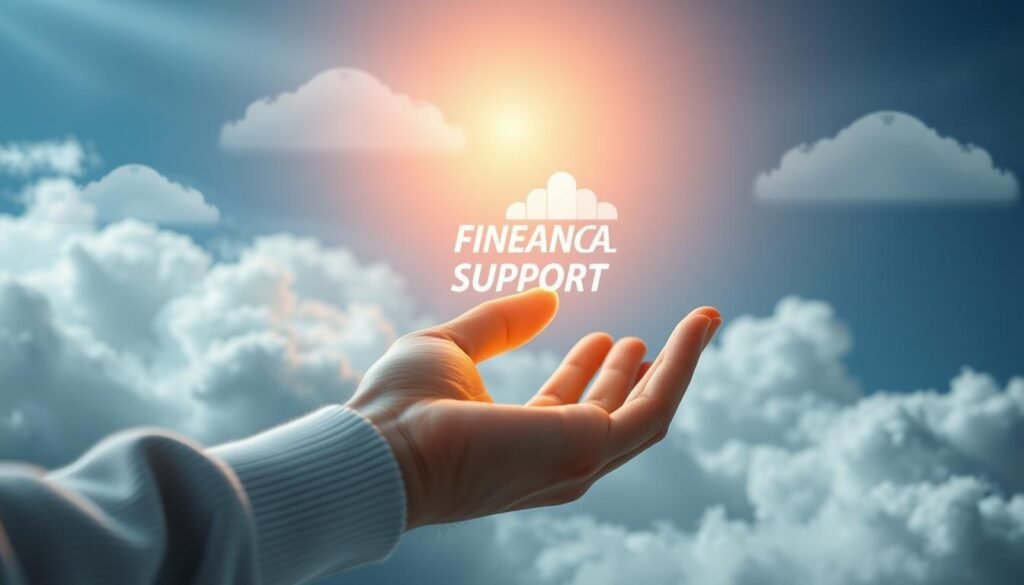Did you know Centrelink’s One-off Crisis Payment (CrP) is a vital help for those in extreme financial trouble? It’s a one-time payment that matches one week’s income support. It’s there to help when you need it most.
The CrP started in 1999 to help people after prison or psychiatric care, and those forced out of their homes. Now, it also helps those affected by domestic violence and new humanitarian visa holders in Australia.
With COVID-19, a special CrP was added in March 2020 for those in quarantine or self-isolation. This help ended on 1 October 2022. But the main CrP program keeps being a key support for those in financial trouble.
Major Highlights
- Centrelink’s One-off Crisis Payment provides immediate financial assistance to eligible individuals experiencing severe hardship
- The payment is equivalent to one week’s worth of a person’s maximum basic income support
- Eligibility criteria includes recent release from prison, psychiatric confinement, domestic/family violence, and humanitarian visa recipients
- A temporary COVID-19 related CrP was introduced in 2020 but ceased in October 2022
- The CrP program continues to offer a vital safety net for Australians facing financial emergencies
Crisis Payment Eligibility Requirements
Australians facing extreme situations, like natural disasters or severe money troubles, might get a Centrelink Crisis Payment. This one-time payment aims to offer quick help during hard times. It has certain rules to follow.
Extreme Circumstances Qualification
To get a Crisis Payment for extreme situations, you must have gone through a big event. This event must have badly affected your money situation. For example, natural disasters like bushfires, floods, or cyclones can qualify if they caused property loss or job loss.
This payment is for those who have found themselves in very bad situations without fault.
Income Support Recipients Criteria
To be eligible for a Crisis Payment, you must also be getting an income support payment from Centrelink. This includes JobSeeker, Age Pension, or Disability Support Pension. This makes sure the payment goes to those who are already getting government help and need more.
Severe Financial Hardship Assessment
To show you’re in severe financial trouble, you need to prove your current money situation is very bad. This could be because of the extreme situation you’re in. It might include not having enough money, not being able to pay for basic things, or using up all your savings.
| Eligibility Criteria | Details |
|---|---|
| Extreme Circumstances | – Natural disasters (e.g., bushfires, floods, cyclones) – Significant events that severely impact financial situation |
| Income Support Recipients | – Current recipients of Centrelink payments (e.g., JobSeeker, Age Pension, Disability Support Pension) |
| Severe Financial Hardship | – Loss of income – Inability to pay essential bills – Depletion of savings or other assets |
Knowing these key rules helps Australians in extreme circumstances, needing disaster relief and support see if they can get a Centrelink Crisis Payment. This payment can help them get through tough times.
How to Apply for Emergency Centrelink Assistance
Australians in urgent need due to extreme circumstances like natural disasters can get emergency Centrelink help. To apply, you must show the urgency of your situation and provide the right documents.
To start, contact Centrelink directly and explain your emergency. This could be a sudden job loss, a medical crisis, or the aftermath of a natural disaster. You’ll need to show you’re in a state of special benefit and urgently need financial help.
The Centrelink team will check if you’re eligible for a Crisis Payment. This is a one-off payment for immediate help in catastrophic events. You must show severe financial hardship and meet government criteria.
- Give detailed info about the extreme circumstances leading to your urgent payment request.
- Submit relevant documents, like proof of income loss, medical bills, or disaster-related expenses.
- Show that the situation is causing big financial stress and that the urgent payment is needed to keep living standards.
By working with Centrelink and providing the needed info, those in crisis can get the support they need. This helps them get through tough times and regain financial stability.
“In times of urgent need, Centrelink is there to provide a safety net for Australians facing severe financial hardship.”

Natural Disaster Support and Crisis Payment
Centrelink offers extra help during natural disasters. This includes Crisis Payments and other disaster relief. These options provide emergency support to those affected by big events.
Disaster Relief Options
Centrelink has many disaster relief options. These include financial grants and support for communities hit by disasters. People can get help with essential costs.
Immediate Support Measures
After a disaster, Centrelink acts fast to help. They offer extended payment periods and childcare subsidies. They also help with early superannuation access in some cases.
Documentation Requirements
While rules might change in emergencies, you’ll need to show proof. This could be where you live, receipts for important things, and more.
| Disaster Relief Assistance | Details |
|---|---|
| Financial Grants and Support Services | Available for individuals and communities affected by bushfires, cyclones, and other natural disasters |
| Personal Hardship Assistance | Grants to cover essential expenses for those in need |
| Utility Bill Support | Extended payment periods and assistance with gas, electricity, and telephone bills |
| Childcare Subsidies | Extra help with the cost of childcare for families in flood-affected areas |
| Superannuation Access | Early access to superannuation funds in limited circumstances |
Centrelink is ready to help in emergencies. Knowing what support is available and what you need to show can help. This way, you can get through tough times caused by disasters.
Crisis Payment for Domestic Violence Victims
Victims of domestic violence can get Crisis Payment support. This is a vital help that gives immediate money to those leaving abuse. It’s a big help, letting people and families get the money they need to start over.
In New South Wales, the Immediate Needs Support Package (INSP) gives up to $5,000. It helps with moving costs, security, and other important things. You need to show proof of the violence and new home within 2 years.
Centrelink also has a Crisis Payment. It’s for a week and helps those who have faced violence and are struggling financially. You must contact Centrelink within 7 days and apply within 14 days.
For those on temporary visas, the Red Cross Payment can help. It gives up to $5,000 for those facing violence and money troubles. The Escaping Violence Payment helps women and children leave violent relationships with up to $5,000.
These programs are a big help. They offer financial hardship, urgent payment, and temporary support. They help victims of domestic violence start a new, safer life.
“The crisis payment was a godsend. It gave me the urgent funds I needed to leave my situation and start over. It’s a program that truly makes a difference in the lives of those affected by domestic violence.”

Financial Hardship and Emergency Relief Services
When money is tight, emergency relief services can be a big help. Charities and community groups offer support with food, bills, and transport. Knowing where to get help can make a big difference for those in crisis.
Food Voucher Programs
Foodbank Australia, OzHarvest, and SecondBite help with food. They give vouchers or food directly to those in need. This is a big help for families struggling to buy food.
Utility Bill Assistance
The Salvation Army (13 72 58) and St Vincent de Paul Society (13 18 12) help with bills. They ensure people keep their essential services on during tough times.
Transport Support Options
- Some services offer transport help, like vouchers for buses or fuel. This keeps people moving and accessing important services.
- Looking into local groups or government sites can reveal transport help in your area.
Using these services can help people in financial hardship get back on their feet. It’s a way to find stability again.
Advance Payment Options Through Centrelink
Centrelink helps those in urgent need with advance payment options. This isn’t an extra payment but an early release of funds. It’s for people facing urgent payment, temporary support, or financial hardship.
Centrelink’s hardship advance payment lets eligible people get part of their first payment early. You need to show you’re in severe financial trouble. Your total liquid assets must be less than twice the fortnightly maximum payment rate.
| Hardship Advance Payment Key Facts | Details |
|---|---|
| Recovery Process | The advance is usually taken back by withholding up to 14 days of your first payment. You can spread the repayment over the first and second payments to ease the financial burden. |
| Eligibility Criteria | To get the advance, you must be in severe financial hardship. This includes those being released from prison or psychiatric confinement. |
| Frequency Limits | You can only get a maximum of 2 urgent payments in 12 months. There are exceptions for very special cases. |
Centrelink staff must check each application carefully. They make sure other help can’t solve the financial problem before giving an urgent payment. They also consider people with psychiatric or intellectual disabilities carefully.

Centrelink’s temporary support options aim to help individuals and families in need. They provide a safety net for those facing urgent payment and financial hardship. This helps them get through tough times with dignity and care.
Emergency Housing Support and Crisis Payment
In Australia, state and territory governments help with housing crises. They offer low-cost hotels, motels, and caravan parks for emergency stays. These crisis payment and emergency assistance services give temporary support to those in urgent need.
Temporary Accommodation Options
People facing a housing crisis can get help from their state or territory housing department. They offer emergency stays until a permanent home is found.
Rental Assistance Programs
Rental assistance programs help with rent costs. They cover the initial bond and provide ongoing subsidies for monthly payments.
Bond Payment Support
Some governments help with bond payments for rental properties. These crisis payment options make it easier to rent a home.
These government-funded emergency assistance and temporary support services help people in housing crises. They provide stability and support towards finding a permanent home.
Indigenous Australian Crisis Support Services
In times of crisis, specific support services are available for Aboriginal and Torres Strait Islander peoples in Australia. These services are designed to provide culturally appropriate assistance and resources. They help Indigenous Australians navigate financial hardship, emergency situations, and other challenges.
Dedicated Crisis Hotlines
- The Mob Strong Debt Helpline (1800 808 488) offers free financial counselling and support for Indigenous Australians facing financial crises or emergency situations.
- 13YARN (13 92 76) is a 24/7 crisis support line dedicated to providing assistance to Aboriginal and Torres Strait Islander individuals in distress.
Health and Community Services
The National Aboriginal Community Controlled Health Organisation (ACCHO) plays a key role in delivering health-related support services to Indigenous Australians. These services include crisis assistance, referrals, and access to essential resources during times of emergency or financial hardship.
Trauma-Informed Support
Organisations like The Healing Foundation are dedicated to supporting the healing of Indigenous communities from the trauma caused by historical events. They offer a range of programs and resources to help Aboriginal and Torres Strait Islander peoples navigate crisis situations and access the support they need.
Inclusive Crisis Services
For Indigenous Australians who identify as LGBTQIA+, the Black Rainbow organisation provides culturally appropriate support and crisis services tailored to their specific needs and experiences.
By understanding and accessing these dedicated crisis support services, Aboriginal and Torres Strait Islander peoples can receive the targeted assistance they require during times of crisis, emergency, or financial hardship.
Special Benefit and Additional Support Measures
The Australian government has a Crisis Payment through Centrelink. It also offers a Special Benefit for those in financial hardship. This program is a safety net for people who can’t earn enough or get other support during unforeseen crises.
Supplementary Assistance Programs
The Special Benefit helps with emergency assistance for living costs. This includes rent, utilities, and basic needs. Centrelink checks if you really need it, making sure it goes to those who are struggling the most.
Emergency Healthcare Support
Centrelink also helps with emergency healthcare needs. You might get cheaper medical services, prescription drugs, and temporary places to stay near hospitals. This way, people in unforeseen crises can get the care they need without worrying about money.
Essential Services Access
Centrelink works with utility companies and councils to help with basic services. This includes electricity, water, and public transport. It’s all about keeping life basic and stable during tough times, so people can recover and get back on their feet.
“Centrelink’s support measures are key in helping Australians through unforeseen crises and getting back on their feet financially.”
State-Specific Crisis Support Programs
While Centrelink’s Crisis Payment is vital, each state in Australia has its own crisis support. These programs meet local needs and offer specific help for those in financial trouble.
In New South Wales, Link2home (1800 152 152) is available 24/7 for emergency housing. Victoria’s HousingVic (1800 825 955) helps with rent and temporary shelter. These services make sure people get the right help for their area.
Together, Centrelink and state programs create a strong support network. This helps people in financial or emergency situations. It means everyone, no matter where they are, can get the help they need.
